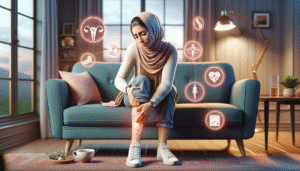Common Causes and Effective Remedies for Leg Pain in Women

Ever found yourself struggling with aching legs after a long day, even when you haven’t done anything particularly strenuous? You’re not alone. Leg pain in women is more common than you might think, and it can sneak up on you for a variety of reasons.
Whether it’s a dull ache, sharp stinging, or cramping that kicks in out of nowhere, leg pain can really put a damper on your daily life. Let’s dive into what causes it, how to spot the symptoms, and what you can do to get some much-needed relief.
Why Do Women Experience Leg Pain More Often?
Our bodies go through a lot, and for women, hormonal changes, lifestyle factors, and certain health conditions can make leg pain more likely. Think of it this way: your legs are like the foundation of your home. When something’s off-balance, everything feels it.
Here are some of the most common causes of leg pain in women:
- Muscle Strain: Overusing your legs, especially after exercise or physical activity, can lead to sore and strained muscles.
- Poor Circulation: Reduced blood flow due to conditions like peripheral artery disease (PAD) or varicose veins can cause cramping and discomfort.
- Hormonal Changes: Fluctuations during menstruation, pregnancy, or menopause can lead to fluid retention and muscle fatigue.
- Nerve Issues: Conditions like sciatica or diabetic neuropathy can cause shooting or burning pain down the legs.
- Vitamin Deficiencies: Not getting enough vitamin D, calcium, or magnesium may lead to muscle spasms or cramps.
- Arthritis: Swelling and stiffness in the joints, especially the knees and hips, can radiate pain down the legs.
- Deep Vein Thrombosis (DVT): A serious condition where blood clots form in deep veins, often in the legs, can cause sudden and painful swelling.
Have you noticed that your leg pain tends to get worse at certain times of the month? Or maybe it flares up when you’ve been sitting or standing for too long? These patterns can be clues to what’s really going on inside your body.
Recognizing the Symptoms
Leg pain isn’t always straightforward. It can come in many forms, from a constant ache to sudden muscle cramps in the middle of the night. Pay attention to what’s happening and when.
Some typical symptoms include:
- Dull or throbbing pain in the thighs, calves, or feet
- Pins and needles or numbness
- Swelling or heaviness in the legs
- Muscle cramps or spasms
- Skin discoloration (especially in cases of poor circulation)
If the pain comes on suddenly or is accompanied by redness and swelling, it’s important to see a doctor right away. This could be a sign of a blood clot or another serious issue.
Proven Home Remedies and Treatments for Leg Pain
The good news? There are plenty of ways to treat leg pain—many of which you can try from the comfort of your own home. The key is figuring out the root cause and adjusting your habits accordingly.
Simple Remedies That Work:
- Warm Compresses: Applying heat can improve blood flow and relax tense muscles. Use a warm water bottle or heating pad for 15-20 minutes.
- Cold Packs: If your pain is due to swelling or a recent strain, an ice pack can help reduce inflammation.
- Stretching & Light Exercise: Gentle movements like yoga or walking can ease stiffness and improve flexibility. Think of your body like a car—it needs to stay in motion to run smoothly.
- Massage: A slow, firm massage can do wonders. You can use essential oils like eucalyptus or lavender for added relief.
- Hydration: Drinking plenty of water helps prevent cramps, especially if you’re prone to nighttime charley horses.
- Proper Footwear: Ditch those high heels! Wear shoes with good arch support to avoid strain on your legs and back.
- Leg Elevation: After a long day, prop up your legs with pillows to reduce swelling and promote blood flow.
I remember a friend who used to battle regular calf pain after long hours at her standing desk job. Just elevating her legs for 10 minutes after work and switching to cushioned sneakers significantly improved her day-to-day comfort. Sometimes, simple changes go a long way!
When to See a Doctor
While many cases of leg pain get better with home care, there are times when you shouldn’t wait to seek medical help.
Seek immediate help if you notice:
- Sudden swelling in one leg
- Intense pain that doesn’t go away
- Skin that feels warm and red
- Numbness that lasts over time
- Pain accompanied by chest discomfort or shortness of breath
These could signal serious conditions like a blood clot or nerve damage, and early treatment could make all the difference.
How to Prevent Leg Pain in the Future
As the saying goes, “An ounce of prevention is worth a pound of cure.” If you want to keep leg pain at bay, making healthy lifestyle changes is key.
Top Prevention Tips:
- Move Often: If you sit a lot, take breaks to walk or stretch every 30 minutes.
- Eat a Balanced Diet: Include foods rich in calcium, magnesium, and vitamin D to support muscle and bone health.
- Maintain a Healthy Weight: Extra weight can put added pressure on your joints and muscles.
- Listen to Your Body: Don’t push through pain. If your legs feel tired or sore, allow them time to recover.
- Avoid Smoking: Smoking can reduce circulation and worsen several leg conditions.
Remember, your legs carry you through life—literally. Taking a few extra steps to care for them now can help you stay active and pain-free later.
Final Thoughts
Leg pain in women is more than just an annoyance—it can be your body’s way of telling you something is off. Whether it’s poor circulation, hormonal changes, or just everyday wear and tear, understanding the causes can help you find the right solution.
So next time your legs are aching after a day on your feet, don’t just brush it off. With the right approach, a little self-care, and knowing when to seek help, you can keep your legs strong, healthy, and ready for whatever life throws your way.
Got leg pain? Start today with these small changes, and give your legs the TLC they deserve!
Follow us on Instagram for more health-related videos, Hprime Labs Instagram




